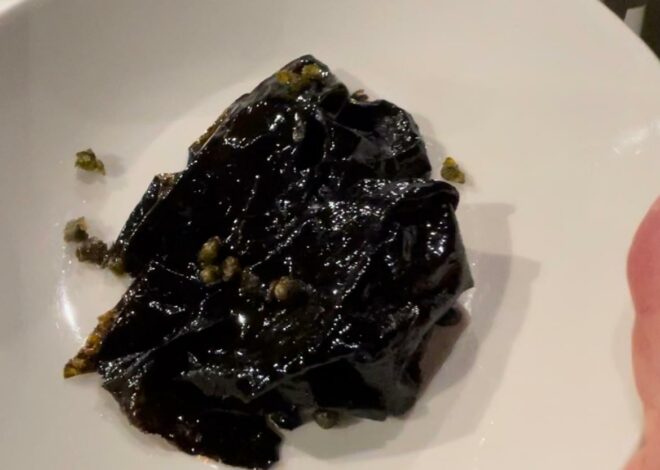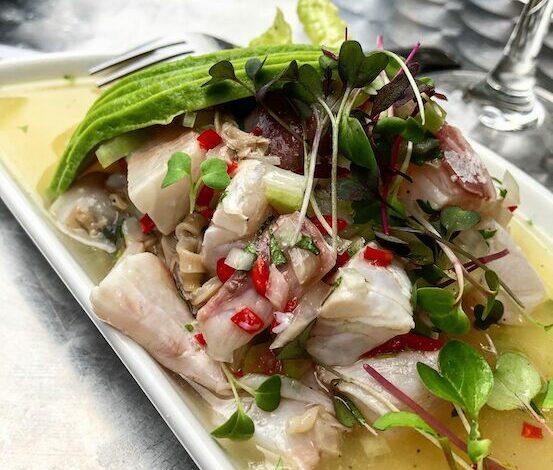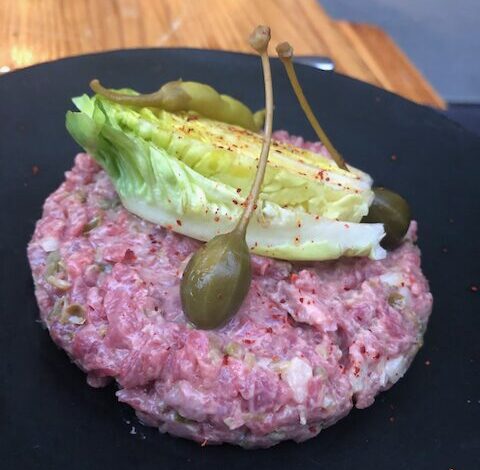
Monday Lunch at Ibai
It was a regular Monday morning at the office, back in 2018 when Diego Prado came up to my desk and asked,
“Do you have cash, like, a lot of cash?”
Diego Prado is the most generous person I know when it comes to spending large amounts of money at a restaurant. He’s a risky choice to put in charge of ordering when you’re dining with a group. But if you set aside material things and imagine for a second that swiping a credit card doesn’t hurt, he tends to create memorable dining experiences with his choices.
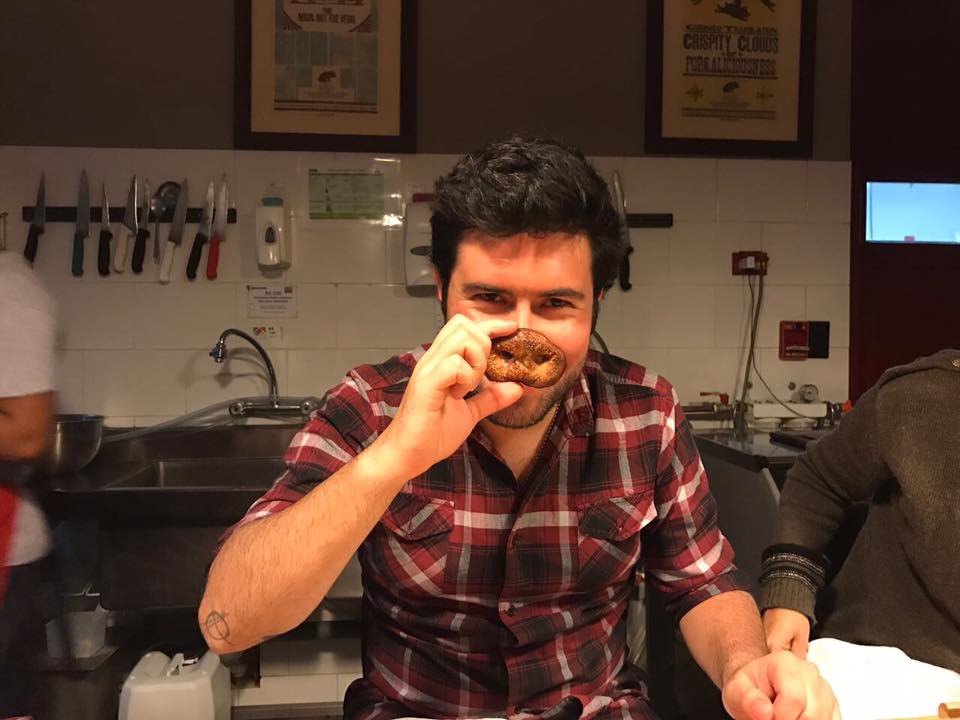
“Let’s see. I happen to have about 200 euros in my wallet.”
I don’t usually carry so much cash, but that week, I happened to be without my debit card, so I had to withdraw money for the whole week.
“No, that’s not enough. I’ll give you an extra 100 euros.”
“Why? What’s going on?”
“They only accept cash. Do you want to have lunch with Shinobu Namae? He can’t go alone. I’d go myself, but nobody will cover my meal expenses, so if you want, you can go instead.”
I knew Shinobu Namae was in town, a 2-Michelin-star chef from Tokyo, where he runs the acclaimed L’Effervescence. Shinobu trained under Michel Bras, has a naturalistic approach to his cooking, applying Bras’s spirituality to Japanese cuisine.
“Where?”
“At Ibai.”
“I don’t know it, but sure, I guess. Okay”
I trust that he wouldn’t send me on a mission like that for no reason. I could go, spend that much money, and come back to the office after lunch.
“You can only make reservations by phone – he explained – they don’t take credit cards, and they can be rude, so it’s better if someone goes with him.”
“Rude how?”
“The last time we reserved for 7 people, but only 5 of us showed up, and they called us jerks when we walked in.”
“Who did?”
“The host and the chefs. There are only 3 people working there. You’ll see.”
Diego left me with 100 euros more to make it 300.

I met Shinobu Namae to exchange some dollars at the old Sabadell bank in the city center.
Not too far from there, Ibai was lurking, but it didn’t really look like we were approaching the entrance to a legendary restaurant. Shinobu and I were wandering around, unable to find the entrance when suddenly, we spotted what looked like an abandoned bar with a sign that clearly said “Ibai.” We walked into an empty bar, and beyond it, there were some stairs leading downstairs. It reminded me of the entrances to underground techno clubs in Berlin.
We found ourselves in a closed-off room in a basement, with no windows. Yet, it gave off the feeling of being in a special place, straight out of a fairy tale. There were only 5 or 7 tables fairly close to each other.
The host, a Basque woman in her 40s with rough manners, was surely the central character of the story I had been told. She handed us a simple laminated menu. We decided to order almost everything on the menu. While we waited, we had a pleasant conversation. Shinobu spoke slowly, as if he was carefully considering each word before uttering it, and his words always held something insightful.
He spent a good amount of time telling me about the best rice he had ever tasted, oddly enough, it was in Korea, not Japan. I tried asking him about various things.
Then, I do recall something he mentioned about dashi.
“Dashi is like the heart of Japanese cooking. We get it from kombu in the north and katsubosuhi in the south. These ingredients give the broth a great aroma and lots of umami. That’s what dashi is all about. To me, it’s not just about cooking; it’s also about the stories, traditions, and where these ingredients come from. When you use really good ingredients, dashi becomes something amazing, the secret base of Japanese taste.”
When we eat, our taste buds identify five flavors: sweet, salty, sour, bitter, and umami. Umami, a savory flavor, is triggered by glutamate in food. It was first described as ‘osmazome’ in 1825, refering to a savory taste prominent in various foods. It mainly comes from its natural content of monosodium glutamate (MSG) and specific ribonucleotides in the food. The term “umami” was coined in 1908 by Japanese chemist Kikunae Ikeda. Foods like Ibérico ham and katsuobushi have something called inosine-5′-monophosphate (IMP), which makes umami even tastier. Scientists are trying to figure out how these enhancers make food taste better, and it could change how we season our food in the future.
In his words, he often stressed the importance of trying what he called “real” foods, like “real dashi”, “real tofu”, and so on.
“If you haven’t been to Japan, you haven’t tasted real tofu,” he said.
They brought us some bread, just a plain baguette with tray marks on it. Up until then, I was worried that the food might not live up to the hype.
“Well, maybe the bread isn’t the best in the world,” I said before taking a bite.
“The bread is good,” Shinobu replied after having a taste.
That’s something I’ve learned over the years, and it’s a mistake many people make. Never downplay food with your words before tasting it. If you cook something and serve it, don’t come to the table apologizing that it could have been better.
The chefs, two older gentlemen, came out to the dining area in their impeccable uniforms. They had a friendly, informal, and down-to-earth demeanor.
We started with borage, cardo (thistle) and artichokes in a delicate vegetable nage. This dish took me back to my time in the production kitchen at Mugaritz, where I cleaned hundreds of borage stems, known for their crunchiness and salad stem-like flavor, best known for its edible blue blossoms. Wild cardo, when tenderly prepared, reveals a mild, earthy flavor, a very unknown and underrated vegetable. And perfectly cooked artichoke hearts. The vegetables were substantial, and the broth was subtle. The dish made my mind travel, a great start.
Then, they brought us some grilled kokotxas. Kokotxas are tender, gelatinous fish chins, a Basque delicacy, offering rich, melt-in-your-mouth flavors in every bite. I was about to cut into one of them when one of the chefs, Alicios brother, stopped me and said,
“The kokotxas should be eaten whole,” he said, mimicking taking an imaginary piece to his mouth.

Next up was a dish of angulas with garlic and chili. Quite a delicacy.
I also remember asking Shinobu about the veracity of a Japanese dish I had heard about, where baby loaches resembling angulas were served alive. First they get drunk on Sake. Then they are served alive, swimming in a broth with a silky cube of tofu in the middle. In front of the diner. The broth would be heated, and oh, the diners’ expressions of wonder! as the baby loaches swim desperately for their lives and nestle themselves inside the tofu. In a way, mimicking the origin of life; sperms rushing into an egg.

“Oh yes, that’s called Dojo Nabe.”
Some Japanese preparations never cease to amaze me.
Before the next dish arrived, at the table next to us, a group of Catalans finished their meal and stood up to give the chefs a standing ovation.

Potatoes, eggyolk, and truffles. This was the dish that had been applauded. There was no way this could go wrong. The creamy, gently cooked potatoes blend with the rich yolk, which is practically a sauce on its own. On top, slices of real truffles, the kind that could set off gas leak alarms with their intense aroma.
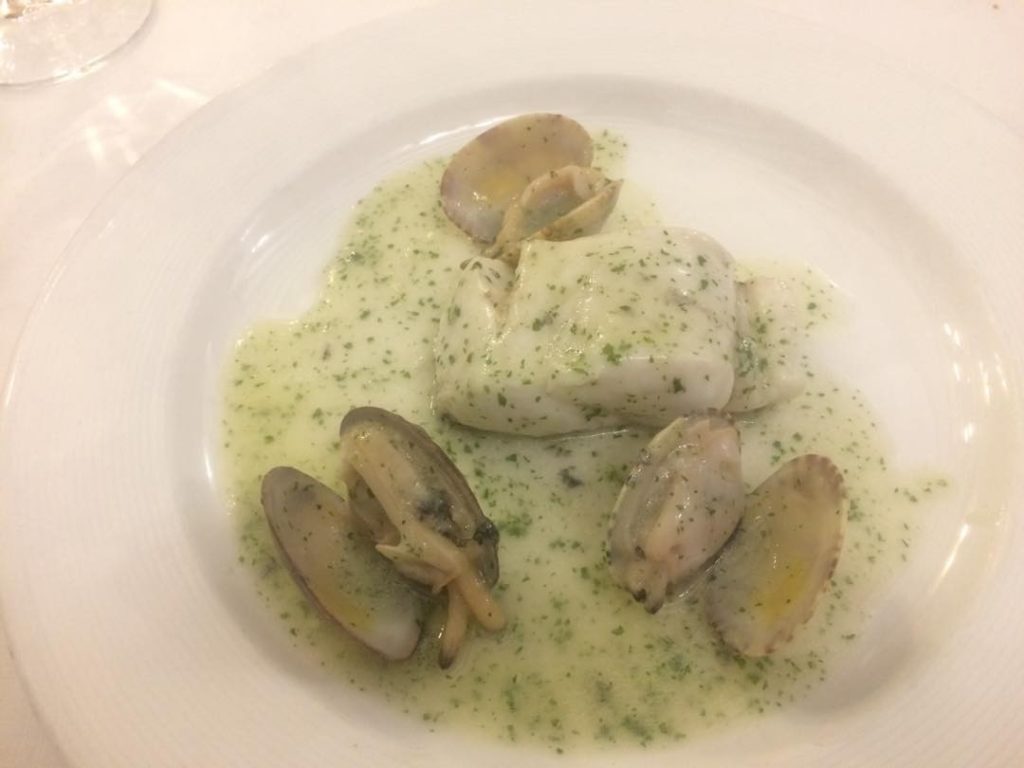
“Merluza en salsa verde,” Atlantic hake in green sauce, it should not be confused with the Mexican sauce of the same name. My favorite dish from Guipuzcoa. When this dish is done right, it embodies the finest qualities of Basque cuisine for me: subtlety, simplicity, texture, and clean flavors.
The fish bone broth is gentle and minimalist, containing nothing more than the bones, and at most, some parsley stems. This broth is thickened with something akin to an olive oil-based roux, over just a touch of ultra finely chopped and sautéed garlic and parsley. The sauce is barely thickened. The salt level is always mild, just a hint of saltiness.
Inside the clam shells is a delightful broth with intense sea flavors, which can occasionally blend with the sauce, enhancing the overall enjoyment throughout the course. The fish is cooked just as it’s traditionally done in the region—barely cooked, not raw. Just enough to gently separate the white, shiny fibers from each other.
It was clear that Shinobu was also deeply moved by this dish. “I would take a plane from Japan just to taste this dish again.”
For dessert, we had a frozen milk tart with almond tiles. Very Basque. It’s the only place in the world where I’ve witnessed such a profound appreciation for the gentle, pure, and subtle taste of pure milk, up to the point to serve it as plain milk ice cream. They seemed store-bought to me and weren’t particularly extraordinary, but it was refreshing and it wrapped up the meal quite nicely.
I was really intrigued by the story of this place. How did chefs with clear high-end culinary training end up running a kind of speakeasy in the heart of the city? It had even been named the best restaurant in the European Restaurant Heritage List. Definitely a hidden gem.
Rumors are going around that Ibai is going to reopen, and it’s going to be run by their longtime chef Alicio Garro, with Paulo ‘El Cordobés’ Airaudo as the operation manager. Of course, they will continue to honor their classic dishes.
The bill for two came to just under 600€, drinks included. I pretended not to feel any pain.
That evening, I shared the meal with Diego. While discussing the hake in green sauce he mentioned that “Fernando puts parsley at the beginning, contrary to the belief that herbs should always go in at the end,” Fernando Barcena, is like the Yoda of Basque cuisine. It makes sense. Parsley is a tough leaf, and it doesn’t lose its color or flavor even with longer cooking times, unlike, let’s say, basil.
Out of everything I told him, the story of the Dojo Nabe caught his attention the most.
He said, “Oh, that’s interesting. I’ll have to tell Ramón.”

Ramón Perisé is one of the creative chefs at Mugaritz. I don’t know if this story had any influence or not, but that year, Mugaritz created one of the most controversial dishes in its history: live spherified baby eels, a dish they called “the origin of life.”

